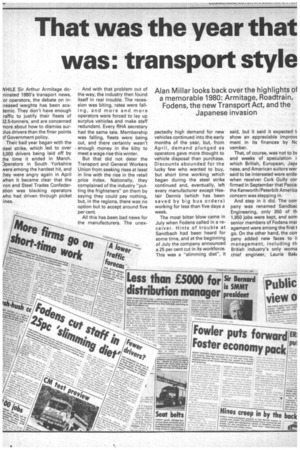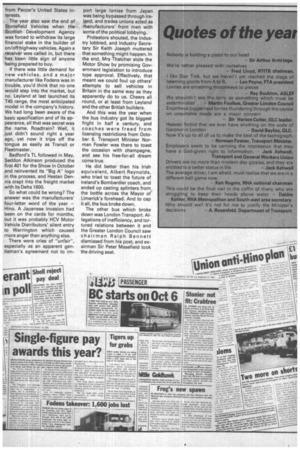That was the year that was: transport style
Page 32

Page 33

If you've noticed an error in this article please click here to report it so we can fix it.
Alan Millar looks back over the highlights of a memorable 1980: Armitage, Roadtrain, Fodens, the new Transport Act, and the Japanese invasion
(VHILE Sir Arthur Armitage doninated 1980's transport news, or operators, the debate on inn.eased weights has been acalemic. They don't have enough raffic to justify their fleets of 32.5-tonners, and are concerned riore about how to dismiss sur)lus drivers than the finer points )f Government policy.
Their bad year began with the 3teel strike, which led. to over 3,000 drivers being laid off by the time it ended in March. Dperators in South Yorkshire tvere among the hardest hit, and :hey were angry again in April tvhen it became clear that the ron and Steel Trades Confeder)tion was blacking operators Nilo had driven through picket in es. And with that problem out of the way, the industry then found itself in real trouble. The recession was biting, rates were falli n g , and more and more operators were forced to lay up surplus vehicles and make staff redundant. Every RHA secretary had the same tale. Membership was falling, fleets were being cut, and there certainly wasn't enough money in the kitty to meet a wage rise this winter.
But that did not deter the Transport and General Workers Union from seeking rises at least in line with the rise in the retail price index. Nationally, they complained of the industry "putting the frighteners" on them by saying they could pay nothing, but, in the regions, there was no option but to accept around five per cent.
All this has been bad news for the manufacturers. The unex pectedly high demand for new vehicles continued into the early months of the year, but, from April, demand plunged as operators gave more thought to vehicle disposal than purchase. Discounts abounded for the lucky few who wanted to buy, but short time working which began during the steel strike continued and, eventually, left every manufacturer except Hestair Dennis (which has been saved by big bus orders) working for less than five days a week.
The most bitter blow came in July when Fodens called in a receive r. Hints of trouble at Sandbach had been heard for some time, and at the beginning of July the company announced a 25 per cent cut in its workforce. This was a "slimming diet", it said, but it said it expected t show an appreciable improv€ ment in its finances by Nc vember.
That, of course, was not to bf and weeks of speculation i which British, European, Japz' nese, and American suitors wer said to be interested were end& when receiver Cork Gully car firmed in September that Paco& the Kenworth/Peterbilt America concern was stepping in.
And step in it did. The con' pany was renamed Sandbac Engineering, only 350 of th 1,950 jobs were kept, and som senior members of Fodens mar agement were among the first t go. On the other hand, the con pany added new faces to ii management, including th British industry's only woma chief engineer, Laurie Bak( from Paccar's United States interests.
The year also saw the end of Stonefield Vehicles when the Scottish Development Agency was forced to withdraw its large financial stake in the builder of on/off highway vehicles. Again a receiver was called in, but there has been little sign of anyone being prepared to buy.
If there was little demand for new vehicles, and a major manufacturer like Fodens was in trouble, you'd think that no one would step into the market, but no. Leyland at last launched its T45 range, the most anticipated model in the company's history. We had long been aware of the basic specification and of its appearance, all that was secret was the name. Roadtrain? Well, it just didn't sound right a year ago, yet now it trips off the tongue as easily as Transit or Fleetmaster.
Bedford's TL followed in May, Seddon Atkinson produced the first 401 for the Show in October and reinvented its "Big A" logo in the process, and Hestair Dennis crept into the freight market with its Delta 1600.
So what could be wrong? The answer was the manufacturers' four-letter word of the year Nino. A Japanese invasion had been on the cards for months, but it was probably HCV Motor Vehicle Distributors' silent entry to Warrington which caused more anger than anything else.
There were cries of "unfair", especially as an apparent gentleman's agreement not to im
port large lorries from Japan was being bypassed through Ire land, and trades unions acted as manufacturers' front men with some of the political lobbying.
Protestors shouted, the industry lobbied, and Industry Secretary Sir Keith Joseph muttered that something might happen. In the end, Mrs Thatcher stole the Motor Show by promising Government legislation to introduce type approval. Effectively, that meant we could foul up others' attempts to sell vehicles in Britain in the same way as they apparently do to us. Cheers all round, or at least from Leyland and the other British builders.
And this was the year when the bus industry got its biggest fright in half a century, and coaches were freed from licensing restrictions from October 6, Transport Minister Norman Fowler was there to toast the occasion with champagne, and see his free-for-all dream come true.
He did better than his Irish equivalent, Albert Reynolds, who tried to toast the future of Ireland's Bombardier coach, and ended up casting splinters from the bottle across the Mayor of Limerick's forehead. And to cap it all, the bus broke down.
The other bus which broke down was London Transport. Allegations of inefficiency, and tortured relations between it and the Greater London Council saw chairman Ralph Bennett dismissed from his post, and exairman Sir Peter Masefield took the driving seat.












































































